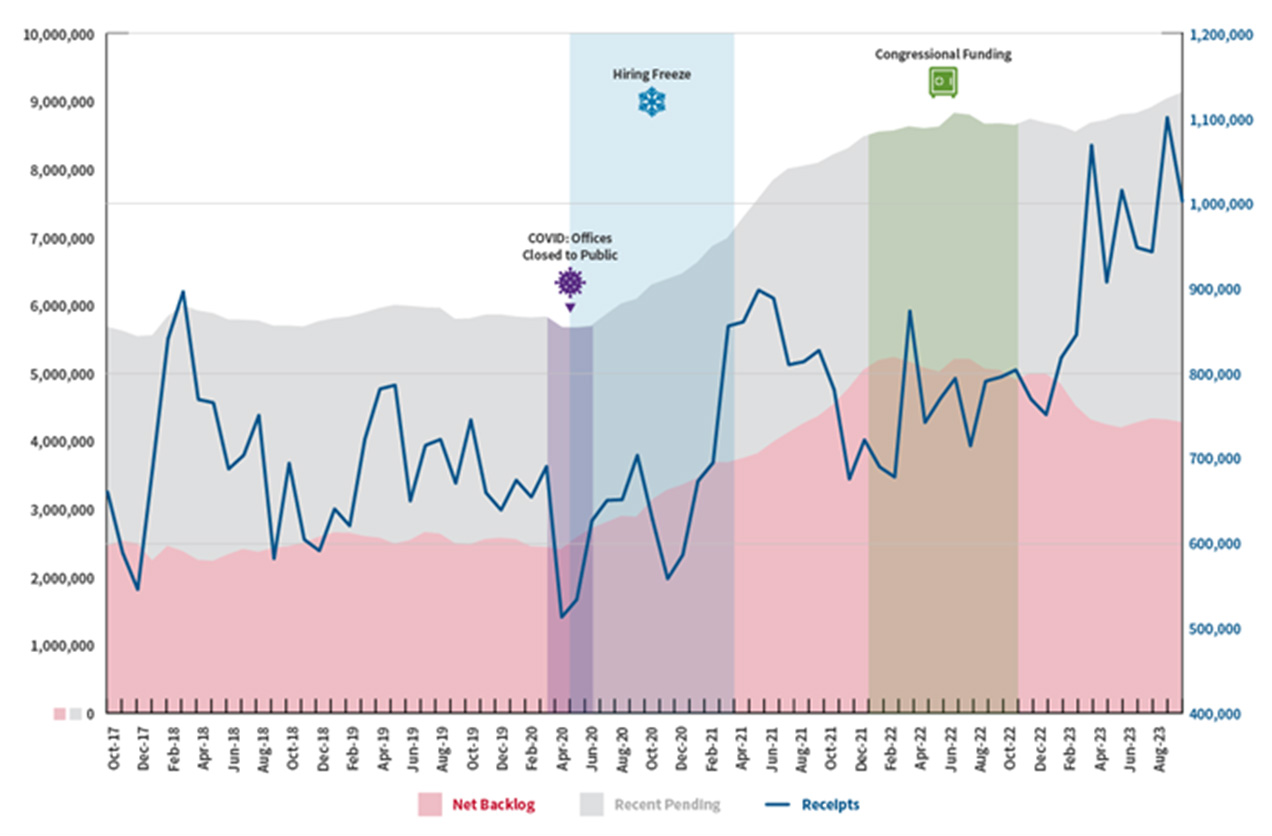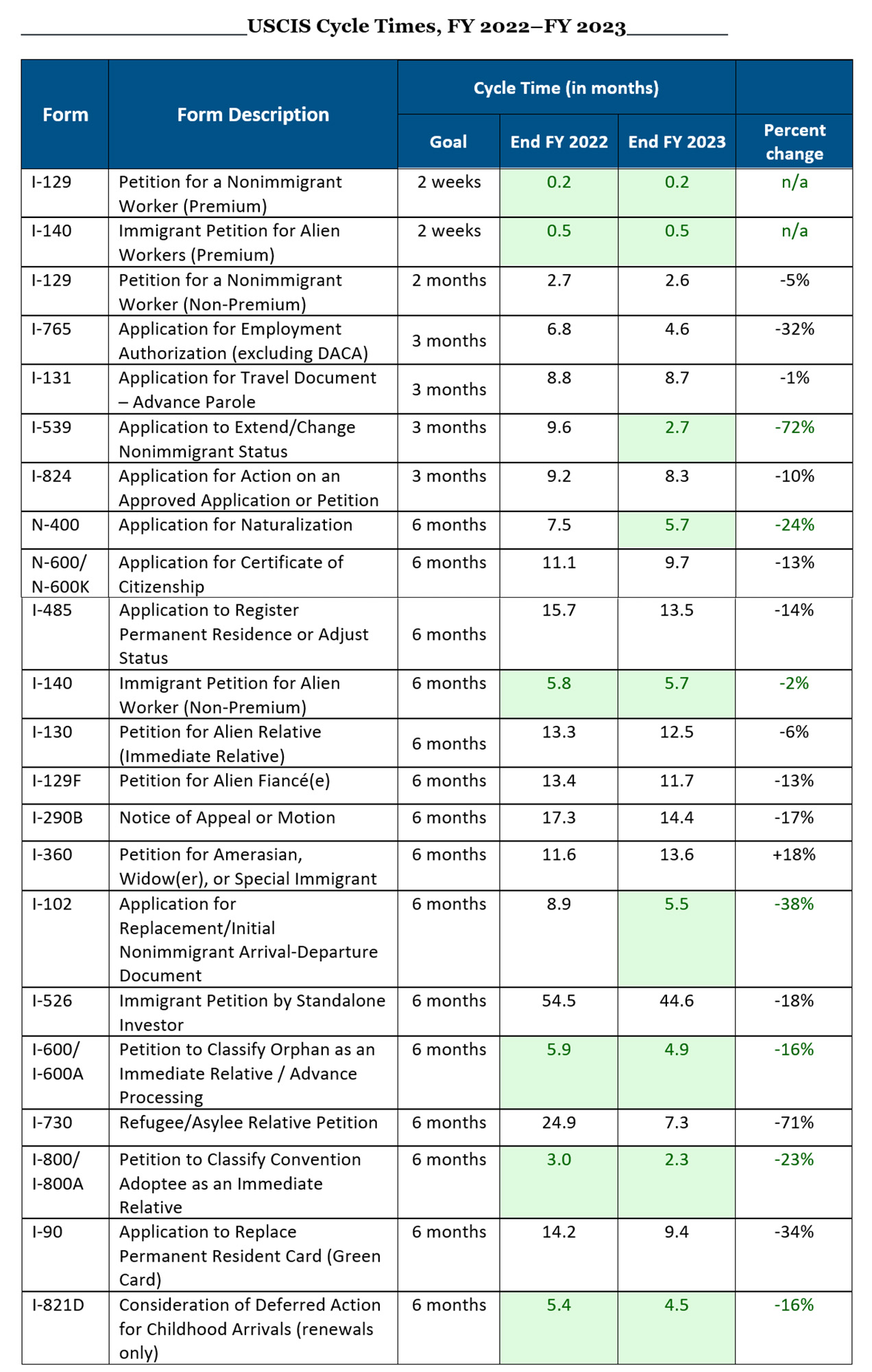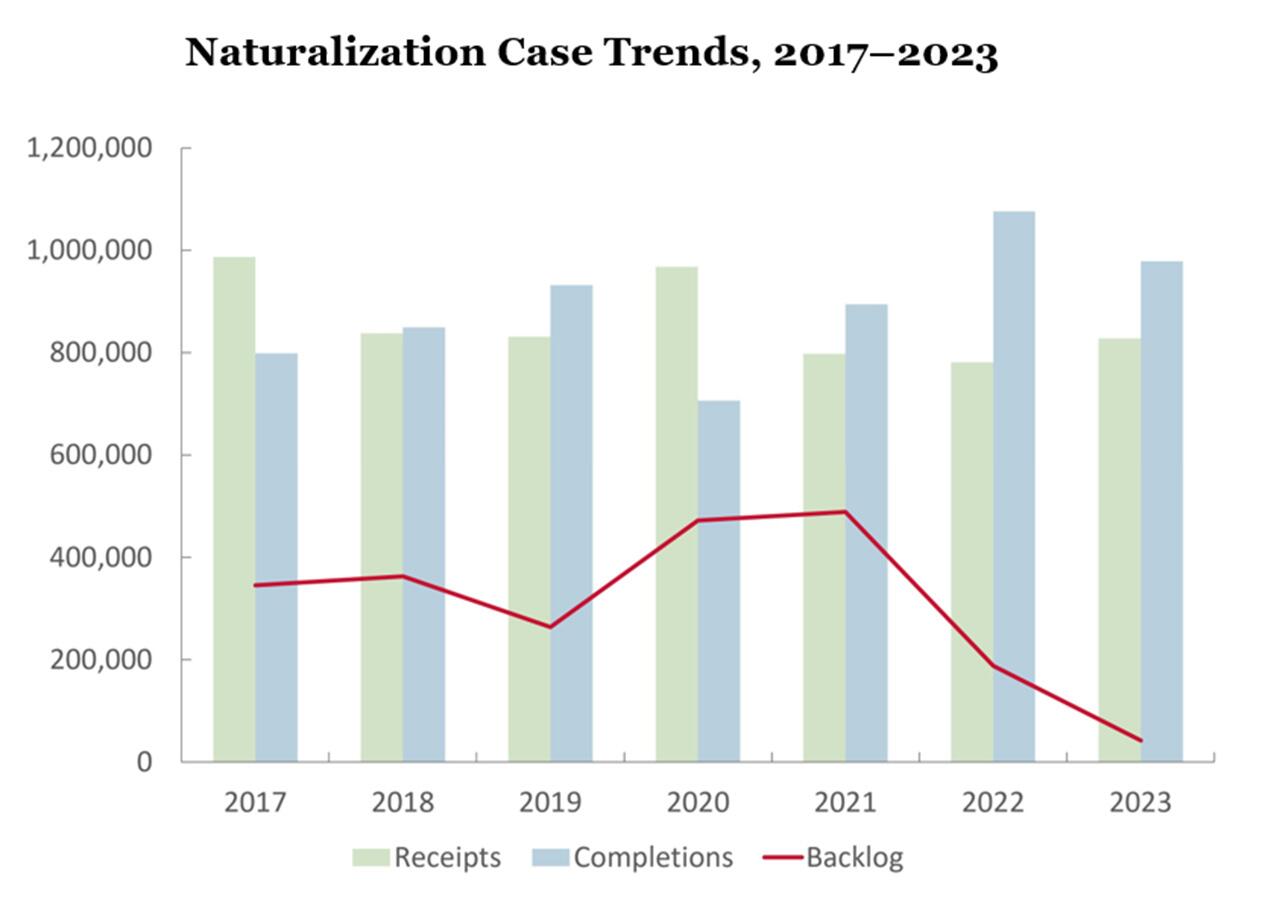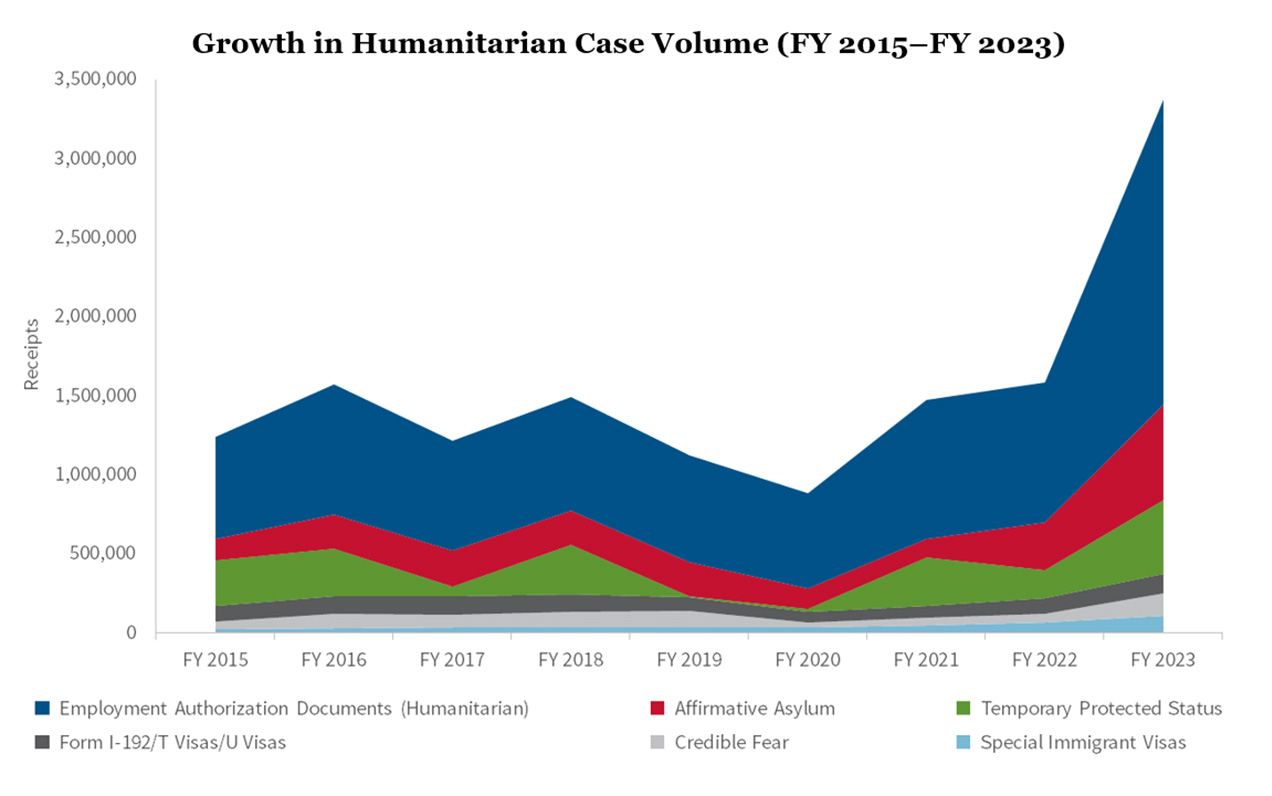
WASHINGTON— Today U.S. Citizenship and Immigration Services (USCIS) is releasing end of fiscal year (FY) 2023 data that illustrate the agency’s progress in meeting its strategic priorities. The USCIS workforce has worked tirelessly over the past year to uphold America’s promise as a nation of welcome and possibility by reducing backlogs, improving customer experience, addressing humanitarian needs, and strengthening employment-based immigration.
“I’m so proud of the USCIS workforce and our dedication to fairness, integrity, and respect for all we serve,” said USCIS Director Ur M. Jaddou. “We’ve completed a record number of cases, responded to emerging crises around the globe with essential humanitarian relief, and applied innovative solutions to improve customer experience and reduce backlogs.”
Reducing Backlogs
In FY 2023, USCIS received 10.9 million filings and completed more than 10 million pending cases– both record-breaking numbers in the agency’s history. In doing so, USCIS reduced overall backlogs by 15%. Among USCIS’ record number of case completions in FY 2023, the agency administered the Oath of Allegiance to more than 878,500 new U.S. citizens, including 12,000 members of the military, effectively eliminating the backlog of naturalization applications . The median processing time for naturalization applicants decreased from 10.5 months to 6.1 months by the end of the fiscal year, achieving the agency’s longstanding goal and significantly reducing waiting times for most individuals seeking U.S. citizenship.
Improving Customer Experience
USCIS implemented several new technology solutions that meaningfully advance the customer experience for those navigating our immigration system. Our new self-service tool for online rescheduling of biometrics appointments was used to reschedule over 33,000 such appointments in FY 2023. Our new enterprise change of address capabilities enabled over 430,000 address changes to be submitted online through Dec. 2023. This tool is expected to reduce USCIS Contact Center phone inquiries by up to 31%, or approximately 1.5 million inquiries annually. From August to September 2023, USCIS received more than 16,000 field office appointment requests using our online request form, while a new text-ahead capability for callers to our 1-800 number gives them a more predictable call-back window and reduces missed calls.
Strengthening Immigration for Workers and Employers
In FY 2023, USCIS and the Department of State helped meet the needs of U.S. employers by issuing more than 192,000 employment-based immigrant visas – far above the pre-pandemic number – and, for the second year running ensured that no available visas went unused. The agency further supported U.S. employers and noncitizen workers in FY 2023 by increasing the maximum validity period of Employment Authorization Documents (EADs) to five years for adjustment of status applicants. We clarified eligibility for a range of immigration services, including the International Entrepreneur Rule, the EB-1 immigrant visa for individuals of extraordinary ability and outstanding professors and researchers, and the waiver of the two-year foreign residence requirement for J-1 cultural and educational exchange visitors (including foreign medical graduates). We proposed a new rule to strengthen worker protections and the integrity of the H-2 temporary worker program.
USCIS also removed the biometrics fee and appointment requirement for applicants for a change or extension of nonimmigrant status and updated the agency’s interpretation of the Child Status Protection Act to prevent many child beneficiaries of noncitizen workers from “aging out” of child status, allowing them to seek permanent residence along with their parents.
Fulfilling Our Humanitarian Mission
USCIS continues to address growing humanitarian needs around the globe, as individuals seek protection in the United States from oppression, violence, and other urgent circumstances. At a time when the world is experiencing the greatest displacement of people since World War II, our agency’s dedicated employees continue to advance our humanitarian mission and provide protection to vulnerable populations.
USCIS interviewed over 100,000 refugee applicants – more than double the amount completed in the previous fiscal year – resulting in the admission and resettlement of over 60,000 refugees. As of the end of FY 2023, USCIS completed more than 52,000 asylum cases; this included prioritizing process of asylum cases for Afghan alliance and their families. USCIS also completed a record-breaking 146,000 credible fear and reasonable fear screenings of individuals expressing a fear of return after being encountered at the border.
In FY 2023, USCIS continued to support Biden-Harris Administration efforts to establish lawful pathways that allow for the safe and orderly processing of individuals into the United States through the implementation of new processes for Cubans, Haitians, Nicaraguans, and Venezuelans (CHNV); the creation of new family reunification processes for individuals from Colombia, El Salvador, Guatemala, and Honduras, and the modernization of existing processes for Cuba and Haiti; and by maintaining support for the Uniting for Ukraine (U4U) process. As of the end of FY 2023, more than 150,000 Ukrainian nationals and their immediate family members had entered the United States under the U4U process and nearly 238,000 individuals through the CHNV process. USCIS is also a key partner in the Safe Mobility Office initiative, one of the many ways the United States is facilitating access to safe and lawful pathways in partner countries in Central and South America to prevent refugees and vulnerable migrants from undertaking dangerous journeys and discourage criminal smugglers who endanger the lives of vulnerable noncitizens. USCIS also announced enhancements to the Central American Minors Program, including expanding eligibility criteria for such children to qualify for access to the U.S. Refugee Admissions Program.
USCIS announced the creation of its sixth service center, the Humanitarian, Adjustment, Removing Conditions, and Travel Documents (HART) Service Center, which focuses on adjudicating benefits requests filed by vulnerable populations. USCIS made significant strides in recruiting, hiring, onboarding, and training new hires, growing the HART Service Center by almost 90% in FY23, and enhancing agency capabilities to adjudicate humanitarian and related cases.
Looking Ahead
In FY 2024, the agency is continuing to build on this progress while monitoring and addressing remaining processing delays. USCIS will work to maintain the median processing times of 30 days for certain EAD applications filed by individuals who entered the United States after scheduling an appointment through the CBP One mobile application or through the CHNV processes. The agency also proposed new rules to modernize and improve the efficiency and integrity of the H-1B program for specialty occupation workers. USCIS will work to maintain naturalization processing times and utilize all available employment-based visas.
As a fee-funded agency, USCIS achieved all these accomplishments within the constraints of a fee schedule that was last updated in 2016. We announced a new fee schedule that allows USCIS to more fully recover our operating costs, reestablish and maintain timely case processing, support the development and implementation of tools that further increase our efficiency and improve the customer experience, and help prevent the accumulation of future case backlogs. We continue to call on Congress to pass the Administration’s supplemental funding request, including additional resources for USCIS to cover projected shortfalls and hire additional personnel.
USCIS will continue to build capacity for processing historically high referrals for protection screenings at the southern border, while focusing remaining resources on the unprecedented number of pending affirmative asylum applications. USCIS will continue to increase refugee adjudications to support the target of admitting 125,000 refugees this fiscal year. USCIS also plans to increase refugee processing in the Western Hemisphere through the Safe Mobility Office initiative and is on track to admit between 35,000 and 50,000 refugees from the Western Hemisphere this fiscal year, the largest number from this region in history.
To enhance accessibility for those we serve, USCIS will also continue efforts to expand our international footprint outside the United States and remains committed to Operation Enduring Welcome for Afghan allies. USCIS will also invest additional resources to stand up the HART Service Center.
Finally, USCIS will implement new online filing tools to enhance the customer experience, including adding organizational accounts, launching online filing of H-1B petitions on Form I-129, Petition for a Nonimmigrant Worker, and adding an additional electronic intake channel for submission of forms and evidence in PDF format.
For more information on USCIS and our programs, please visit uscis.gov or follow us on Twitter, Instagram, YouTube, and Facebook.
Progress on Reducing BacklogsAs the federal agency that oversees lawful immigration to the United States, USCIS adjudicates a variety of immigration benefits and requests including naturalization, lawful permanent residency, employment visas, asylum, credible fear and foreign adoptions. By the end of FY 2023, the USCIS net backlog (cases pending outside of target processing times) was 4.3 million cases, down over 760,000 (15%) from more than 5 million cases at the end of FY 2022.
This progress occurred even as the agency experienced a record year in filings received – 10.9 million during FY 2023, compared with a more typical level of 9 million receipts in FY 2022 and FY 2021.
FY 2023 was the first year that USCIS successfully reduced the backlog in over a decade, following a spike that occurred after the onset of the COVID-19 pandemic. The backlog grew by 16% in FY 2022, which was slower growth than the two previous years – 43% in FY 2021 and 26% in FY 2020.
The slower backlog growth rate in FY 2022 and decline in FY 2023 were driven by ongoing efforts to increase hiring and an agency-wide drive to find new efficiencies in case processing. Congress also supported this effort with a crucial $275 million in appropriated funding in FY 2022 which continued to lead to positive impacts on the backlog. Additionally, in FY 2022, Congress also provided $193 million to support OAW, which helped alleviate the cost of unforeseen workloads associated with adjudicating immigration benefits for Afghan allies.
For a more detailed account of how the pandemic and a hiring freeze led to the doubling of the backlog, see our FY 2022 Progress Report (PDF, 1.08 MB). The chart below shows how the dedicated workforce at USCIS has begun turning the tide on our backlogs, even as case receipts rose significantly in FY 2023.
USCIS Pending Caseload and Receipts, FY 2018–FY 2023

Above: USCIS’ total pending caseload by month, consisting of net backlog (pending cases outside of target processing times) and recent pending (cases still within target processing times), along with case receipts by month.
In March 2022, USCIS established new internal cycle time goals for 25 forms to guide the agency’s backlog reduction efforts. A cycle time measures how many months’ worth of pending cases for a particular form are awaiting a decision and are used to gauge progress on reducing backlogs. As cycle times improve, processing times will follow, and applicants and petitioners will receive decisions on their cases more quickly.
USCIS increased capacity, improved technology, and expanded staffing to achieve these new cycle time goals by the end of FY 2023. The following table shows the goals for each form, alongside actual cycle times. By the end of FY 2023, USCIS achieved the cycle time goal for nine of these forms, including naturalization, and reduced cycle times for all but one of the 25 forms identified in March 2022. We achieved these across-the-board cycle time reductions at the same time we received a record number of new cases and responded to growing humanitarian needs.
In FY 2024, USCIS will continue our work to achieve these cycle time goals.

Above: Internally, USCIS monitors the number of pending cases in the agency’s workload through a metric called “cycle times.” A cycle time measures how many months’ worth of pending cases for a particular form are awaiting a decision. As an internal management metric, cycle times are generally comparable to the agency’s publicly posted median processing times, which in turn show the time it took USCIS to process a particular form – from when the agency received the application until a decision was made on the case. Green cells indicate that the actual cycle time was shorter than the agency’s publicly stated goal.
Naturalizing New U.S. CitizensIn FY 2022 (PDF, 1.08 MB), USCIS completed over 1 million applications for naturalization, welcoming the highest number of naturalized citizens in almost 15 years and reducing the net backlog by 62%.
Continuing these positive trends in FY 2023, USCIS completed 975,800 naturalization applications, administered the Oath of Allegiance to over 878,500 individuals, including 12,000 U.S. military service members, and nearly eliminated the net backlog. Factoring in individuals who derive citizenship from their parents, USCIS completed 1,045,600 naturalization cases. The median processing time for naturalization applicants decreased from 10.5 months to 6.1 months by the end of the fiscal year, achieving the agency’s longstanding processing time goal for most individuals seeking U.S. citizenship.

Above: In FY 2023, USCIS completed 975,800 naturalization applications (Form N-400) and administered the Oath of Allegiance for 878,500 new U.S. citizens. Including derivatives (Forms N-400, N-600, N-600K), USCIS completed 1,045,600 naturalization cases and administered the Oath of Allegiance to 883,900 new U.S. citizens.
In FY 2024
In FY 2023, USCIS implemented several new customer experience enhancements for those navigating our immigration system, including the following:
Coming up in FY 2024
USCIS will continue to improve upon the work done in FY 2023 by implementing new tools that enhance the customer experience. In FY 2024, USCIS will deliver:
In FY 2023, USCIS and the Department of State issued more than 192,000 employment-based immigrant visas – far above the pre-pandemic number – and ensured that no visas went unused for the second year running. (The FY 2023 employment-based annual limit was 197,091, plus 6,396 EB-5 visas that carried over from FY 2022 to FY 2023, and minus 10,874 EB-5 visas that Congress allowed to carry over from FY 2023 to FY 2024.)
USCIS further supported U.S. employers and noncitizen workers in FY 2023, with major policy and process improvements including:
In FY 2024
In FY 2024, USCIS is building on this progress by:
USCIS continues to address the growing humanitarian needs of those seeking protection from oppression, violence, and other urgent circumstances. USCIS has seen significant growth in our humanitarian work (including asylum, Temporary Protected Status, and associated EAD applications. Over the last few years, these cases have gone from representing approximately 15% of all USCIS applications in FY 2015 to more than a quarter of new applications in FY 2023.

In FY 2023, USCIS continued to make progress on fulfilling these humanitarian imperatives by:
In FY 2024